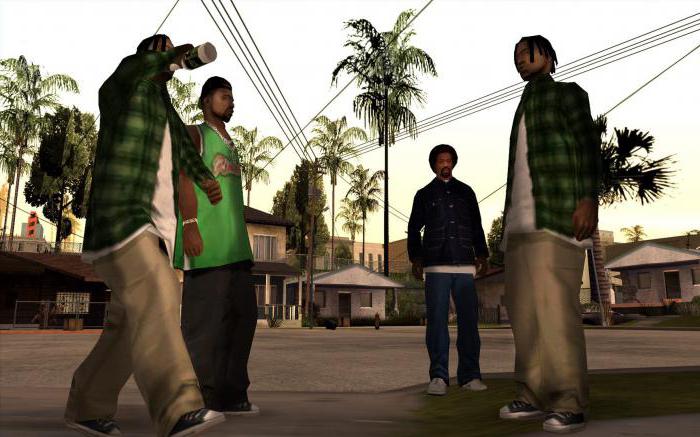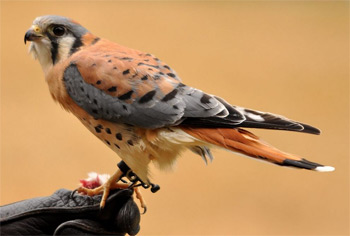A spider with a red booty. Black Thick Head
View: Spider Black Widow (Latrodectus)
Family: Spider-haired dogs
Order: Spiders
Class: Arachnids
A type: Arthropods
Subtype: Helicer
The size: approximately 38 mm in length (paws - 12 mm), 6.4 mm in diameter
The weight: 1 gram
Lifespan: 1 - 3 years
The Black widow got his name because the female often kills and eats the male, which explains his short life. Scientists suggest that so the females get a ready source of protein, which will be useful for offspring. Nevertheless, this is mainly observed in laboratory conditions where the male can not escape.
The black widow unfairly earned a bad reputation. She only eats her husband when she takes it for food! Despite the fierce sounding name, these are non-aggressive creatures, even shy ones. Seldom bite people. We are a much greater threat to them than they are for us. They have a completely romantic ritual: the male dances an amazing marriage dance, so that the female realizes that he is not eating.

Habitat
This species of spider is spread all over the world. They live in regions with a temperate climate, incl. in the USA, Southern Europe, Asia, Australia, Africa and much of South America. Can be found in dark, dry shelters, dimly lit places such as sheds, garages, basements, toilets, hollow stumps, rodent burrows, on the dense vegetation of vineyards. They strive to take shelter in warm dwellings in winter.
Although previously a black widow spider in Russia was not known, in recent years they were found in the Southern Urals and in the Rostov region. Migration is explained by the increase in air temperature.
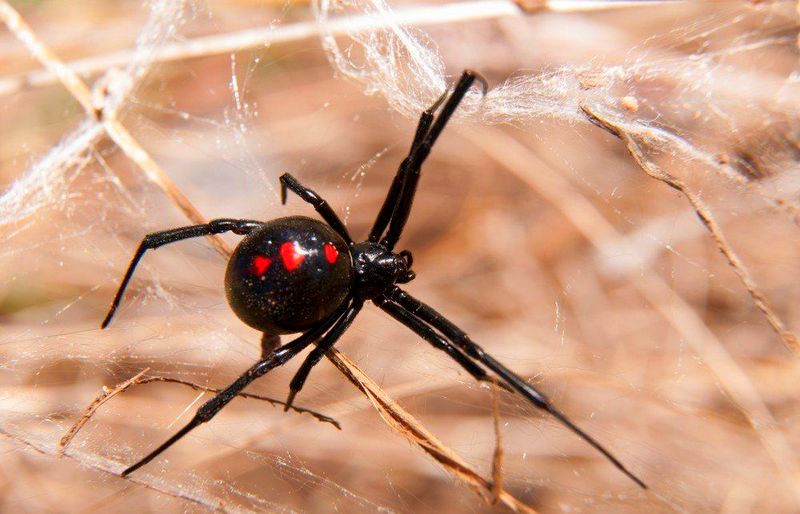
Characteristic
Like all spiders, the black widow has 8 legs. Male and female individuals are different. The females are twice as large, with shiny black organs and a red mark in the form of an hourglass on the lower part of their round belly. The marking can also be orange-yellow. Males are paler, with red or pink spots on their backs. Females about 40 mm long with extended legs, their black, globular abdomens about 9-13 mm.
- Eggs are placed in grayish, silk balls from 12 to 15 mm in diameter. Clutches contain from 200 to 900 eggs and are in a web.
- The couch is first completely white. Then they become like adult spiders, although smaller in size. The spiders of black widows are easy to find in the literature, inet.
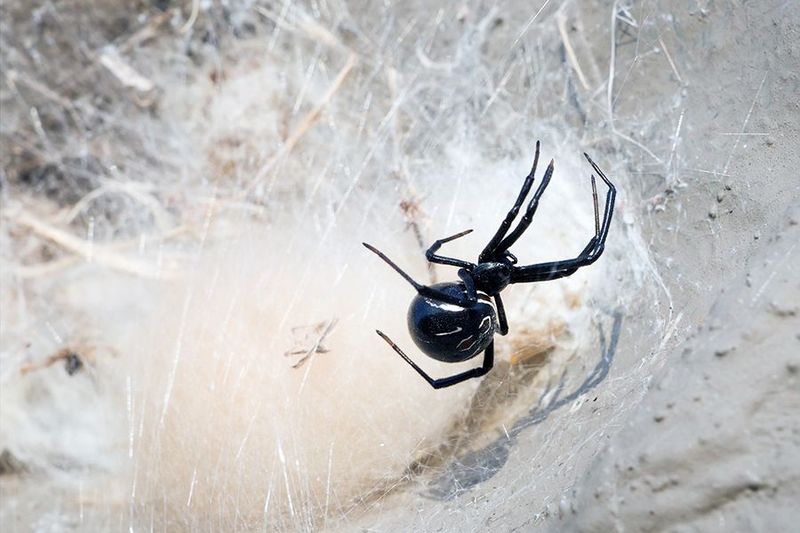
- The spider is a black widow, the photo says about their danger, yet they have enemies. Wasps can sting and paralyze them, also this is the favorite food of the praying mantis. Some birds eat them, but they can eventually get an upset stomach from the poison. Bright red markings on the abdomen warn possible predators that the spider is a nasty food.
- Black widows are alone in nature. They communicate only during mating. They can sometimes be seen hanging upside down in the net, determined by the hourglass on the abdomen.
- A black widow promotes the balance of the ecosystem by consuming insects: mosquitoes and flies. It also controls the number of pests of crops, feeding on insect pests that destroy plants: locusts, grasshoppers, beetles and caterpillars.
Interesting! There are 31 species of the Black widow, including: Latrodectus hersperus (western black widow), Latrodectus mactans (southern black widow) and Latrodectus variolus (northern black widow). There are also red widows and brown widows.

Black widow's bite
The spider is a black widow, whose bite is dangerous, and the poison is 15 times stronger than that of the rattlesnake, fortunately rarely attacks people. Only when a person breaks his peace. Only the bites of females can be considered a threat to human health. And, contrary to popular belief, the majority of victims do not receive serious damage. The bites of this spider rarely lead to death. Risk group - children, old people, patients.
After a bite resembling a pin, the pain spreads throughout the body for several minutes. The consequences of a bite of one member of this genus depend on the species, but the symptoms may include nausea, profuse sweating, severe pain in the abdomen and back, muscle aches, hypertension, shortness of breath. The pain lasts for 8-12 hours, and the symptoms are felt for several days. It is advisable to use an antidote. Animals are more likely to suffer from a male bite.
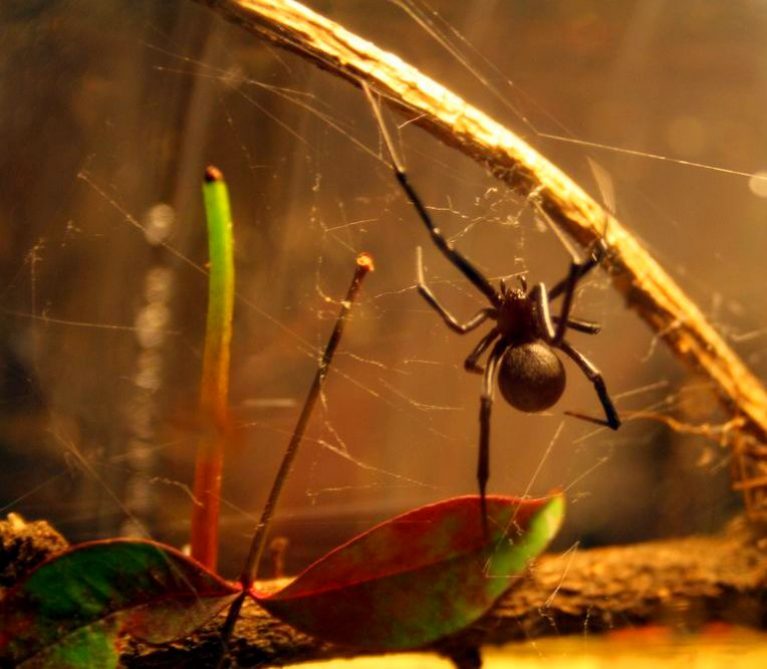
Food
Like many spiders, a black widow eats other arachnids and insects that fall into her net. The female hangs upside down and waits for its prey. This pose demonstrates vivid markings, which are a warning to potential predators that it is toxic. The marking, however, does not frighten the prey.
A spider eats flies, mosquitoes, midges, beetles and caterpillars. After the mining hit the net, the black widow uses his foot-combs to wrap the prey in silk. Then he pierces his prey with fangs and introduces digestive enzymes that dilute the corpse. And sucks out the liquid.
Interesting! Like most spiders, a black widow can live long without food. There are known specimens that survived for almost a year in the absence of prey.

Life cycle
Eggs
A grayish silk ball of eggs with a funnel-shaped outlet is attached to the web. Each female builds from 5 to 15 such balls, 12-15 mm in diameter, each of which contains from 200 to 900 eggs. These masonry are fiercely guarded by mothers until spiders appear from them.
Spiders (infants)
Young spiders leave the ball in 10-30 days. Only a handful of them will survive, since black widows are cannibals in the early stages of their life. They consume other spiders from their brood for the sake of nutrients.

Surviving spiders are molted. At first they are white, then orange, and only after a couple of months they resemble the adult males of a black widow. Surviving individuals leave the network. It will take 2-3 months for them to grow up, begin to weave their canvases and get food.
Interesting! Although the life expectancy of spiders is a black widow - one year, some specimens of females live up to three years. Males, as a rule, are only 1-2 months old. These spiders live longer in captivity.

Content at home
Some originals give birth to all kinds of exotics at home and even try to breed them. Spiders, too, were among the elite. In principle, to contain, feed them is not difficult, there is a lot of information on the Internet, but getting offspring is already a problem.
As for the black widow, one of the most dangerous spiders in the world, experts categorically do not recommend keeping him at home and breeding non-professionals.
Chasing exoticism, you forget about the elementary instinct of self-preservation. The result can be deplorable, because despite the shyness, 5% of the attacks of a similar pet end fatal.

Signs of presence
If suddenly you found a web of a black widow or a spider at home or in the country, be careful. In the room their web can be cleaned with a vacuum cleaner. In fields, orchards and gardens, where these spiders have become a problem, one should put on gloves as a precaution against bites. Spiders can be killed with a pesticide spray.
Black widows produce dirty dense web. Its canvases are usually located near the ground level and under sheltered protrusions, for example, under furniture or a wooden porch on stilts. Red marking in the form of an hourglass will also indicate the presence of this species.
Spider Black Widow got its name due to a special ritual - a female eats a male after mating. However, this does not always happen, often in those cases when the female takes her boyfriend for prey. And how dangerous is this creature for man and how can it be recognized among other spiders?
The Black Widow is one of the most poisonous spiders
Characteristic
Black widows - this is the genus of spiders, numbering 31 species, and they inhabit all the continents without exception. Among them there are special representatives, whose bite is very dangerous for humans.
The description of the black widow spider will largely depend on its species affiliation, but all of them have characteristic features.
- Size - the length of the body of adult male spiders is about 1.2-2 cm, the length of the legs is approximately the same as the body size. Males are about twice as large as females.
- Legs - a black widow has 8 legs. A characteristic feature - paws-ridges. On the back pair of legs there are strong setae of curved shape, which help the spider to close the web over the prey.
- Color - the body of an adult spider, a black widow, as you can see in the photo, is painted black with one red or orange spot that resembles an hourglass shape, or with several red spots. In females that have not reached puberty, the red spots have a white edging. In European species, the stain is colored white-brown. The body of young spiders is white or yellowish-white, after a regular moult it gets a darker shade.
- Sight - the eyes of the black widow are arranged in two rows, each with 4 eyes. The middle pair is basic, the lateral ones are able to distinguish only light and movement.
On a note! Despite the large number of eyes in general, the black widow spider sees very badly. The presence of the victim, he recognizes only the vibration that she creates, being in the web!
 Black widows prefer solitude; communication between females and males occurs exclusively during mating
Black widows prefer solitude; communication between females and males occurs exclusively during mating Development
The fertilized female lays eggs into the cocoon from the cobweb, which she fastens near her nestling net. The cocoon itself is a grayish ball with an outlet in the form of a funnel. Masonry is under constant monitoring of the mother until the spiders appear from the eggs.
Development in the egg takes from 2 to 4 weeks. Young offspring, just released from eggs, immediately enters into the struggle for life. Stronger individuals eat the weak, thus, not all survive. As a result, only a small handful of young black widows leave the cocoon, often up to 12 spiders.
As mentioned above, immediately after the birth of the body of young individuals is painted white. And only after a few lines they will darken enough and will look like adult spiders from the genus of black widows.
 The escape from the cocoon of the surviving spiders takes place in the spring, and at this time they are particularly aggressive
The escape from the cocoon of the surviving spiders takes place in the spring, and at this time they are particularly aggressive Spread
And where does the black widow dwell? Each species is attached to its territory. For example, 8 species of black widows were found on the territory of Eurasia, in the South and North America - 13, in Oceania and on the Australian mainland - 3.In Russia, a certain type of spider, a black widow who is known as the white karakurt, also lives. It can be recognized by the characteristic globular abdomen, which is colored white or yellowish in color. In this case, a bright spot in this black widow is absent. Instead of a figure in white karakurt on the surface of the abdomen there are four grooves forming a rectangle.
 White karakurt is not aggressive
White karakurt is not aggressive
Important! Despite the fact that the poison of white karakurt is much less toxic than that of other black widows, it can be deadly to old people and children!
However, recently due to significant warming, many species of these arachnids have changed their habitual habitats. The black widow in the Crimea, the Caucasus, Taganrog, the Southern Urals and Rostov regions is becoming increasingly heard about the appearance of the spider.
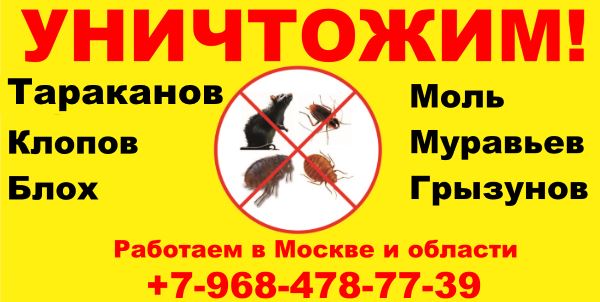
Their spider webs are preferred to hang in dark dry shelters and settle mainly in poorly lit places. Therefore, a meeting with them can occur in sheds, garages, toilets, located on the street, as well as abandoned animal burrows, hollow stumps and even in dense thickets of grass.
On a note! With the arrival of the cold spider, a black widow always moves to a warm room, and therefore in winter they can be found even in a residential building!
 For the web of a black widow, a disordered weaving is characteristic, and, as a rule, it is stretched in a horizontal plane
For the web of a black widow, a disordered weaving is characteristic, and, as a rule, it is stretched in a horizontal plane Consequences of a bite
Female black widows are always more aggressive than males, but if you accidentally disturb the latter, even he is able to attack and bite a person. At the same time, the risk of attack from the spider's side increases many times in the autumn, when he moves to living quarters.
Spider bite black widow is moderately painful - feels like a pin prick. Characteristic symptoms are:
- the expansion of capillaries, which leads to a slight reddening of the skin;
- almost immediately develops edema;
- after half an hour - an hour in the affected area there are muscle spasms, which are accompanied by intense pain;
- then the muscles of the anterior abdominal wall become strained, the pain continues to grow and becomes painful.
On a note! This symptom is often taken for the sign of peritonitis, but at the same time palpation of the abdomen is painless!
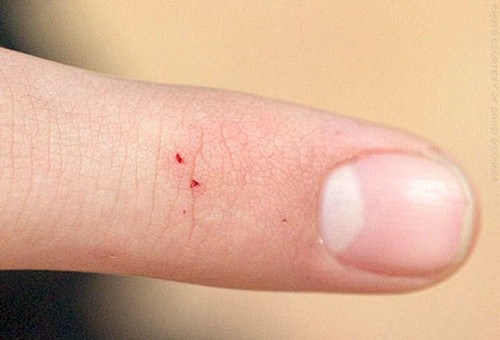 Two small red dots appear on the site of the bite
Two small red dots appear on the site of the bite
Perhaps the development of some additional symptoms, among them:
- increased blood pressure;
- intense salivation;
- sweating swiftly;
- vomiting;
- an attack of severe shortness of breath;
- violation of the heart rate with an increase in heart rate;
- anxiety;
- general weakness;
- headache;
- urinary incontinence;
- muscle twitching;
- a disorder of skin sensitivity: from tingling and "goosebumps" to complete numbness.
There is also an allergic reaction to the poison. After biting, it is desirable to introduce an antidote as soon as possible. After three hours there is a big risk of aggravating the already serious condition of the victim, up to a lethal outcome.
On a note! In the best case, delay is fraught with an irreversible trauma to the nervous system and a worsening of the mental state without the possibility of its recovery or even minimal improvement!
To avoid trouble, watch spiders when spending time outdoors or in a country house, and under no circumstances take them in hand.
Want to get rid of harmful insects? We recommend professional service of pest control:
- Work experience more than 12 years;
- Departure to anywhere in Moscow;
- Work day and night;
- Modern equipment and powerful insecticides;
- Contract and guarantee.
Among all the inhabitants of the earth, spiders have an unusual, even frightening appearance, and can live in different conditions: from deserts to tropical forests.
Nature has endowed spiders with a large number of legs, with which they quickly move, the ability to weave a spider's web, and some of them are endowed with the strongest poison, capable of even killing a person. Here we will present today the 10 most poisonous spiders inhabiting our planet, and find out where the most poisonous spider in the world lives.
Heyrakantium

Opens our top ten Heyrakantium, who chose to live in South Africa and some areas of Asia. This dangerous spider can be found in Europe.
Spider of small size, only 5-10 mm has a pale color with yellow, and sometimes beige tinge of the abdomen.
The bite of a spider is not fatal, but causes severe pain at the bite site, redness and swelling. Sometimes, to get rid of the painful sensations, it is enough to rinse the bite with cold water.
Chinese tarantula
The inhabitant of Southeast Asia has a toxic poison capable of immobilizing and even killing a small mammal. In history, even the death of an infant from the bite of this large tarantula is recorded.
Adult individuals reach rather large sizes with paw length up to 20 cm. To develop an antidote, scientists conducted experiments, and found that a small dose of poison led to the death of most of the laboratory mice.
Goliath aviary

In size, it is the largest spider in the world. Its size and poison allow hunting for toads, frogs, some species of lizards, and sometimes small snakes become its victims.
The torso of the Goliath tarantula, as this species is also called, reaches 9 cm. In the middle of the twentieth century a specimen was caught in South America, its feet reaching 28 cm.
The poison is not fatal to humans, but the Bird of Goliath (Terafosa Blondi) bites only in case of extreme danger. It prefers to dwell in the humid tropics of Brazil, so it is not possible to meet it in our latitudes.
Chilean hermit spider

Extremely poisonous spider, whose poison after a bite causes necrosis of the skin and subcutaneous tissue. The most dangerous thing is that the bite is painless, like a needle prick.
This dangerous arthropod is relatively small from 0.6 to 2 cm. It is characterized not by aggressive behavior, but encounter with it is undesirable.
Different species live in a temperate climate and perfectly adapted to a human-altered environment.

The English call this species of spiders "mouse spiders", mistakenly believing that they, like mice, can dig holes in the ground.
The size of Missouli is from 1 to 3 cm, because of which small spiders eat mainly insects, catching them in their intricate web.
The mouse spider lives in Australia, and with the beauty of its appearance, it is considered one of the most poisonous on earth. The bite leads to painful sensations, a tumor and the development of the wound at the site of the bite. Therefore, with a bite, it is better to seek qualified help.

Specialists agreed that this spider is one of the most beautiful. But with its beauty, it is also a most dangerous representative of the fauna.
It belongs to the genus of Spider-Spiders, of which Australia is the birthplace. From the Green continent, they settled all over the planet, and they can be found in different parts of the world, except Antarctica.
The poison of the most beautiful arthropod belongs to the category of neurotoxic, and paresis occurs when the bite occurs, and then, without medical assistance, death.

The most poisonous spider in Russia, karakurt usually lives in the steppes and desert zones. The name is translated as "black worm", but the Latin name conveys the main morphological features.
Males are much smaller than females. Adult female individuals grow to 2 cm. The most dangerous females with red spots on the black body. After a bite, there comes a sharp pain, which eventually spreads throughout the body.
But we note that the karakurt attacks and bites with the release of poison only at a time when it feels threatened.

It is difficult to find on Earth a man who did not hear about the most dangerous spider - the Black widow. Poison causes the strongest muscle spasms, paralysis, and sometimes death.
Among these spiders, sexual cannibalism is common. After mating, the female eats its partner. Note that the poison released by this spider is several times more deadly than the poison of the rattlesnake.
A black widow can be easily distinguished by characteristic red spots in the form of an hourglass on a black back.

One of the few representatives of the family of migalomorphic spiders, which can cause great harm to human health, and sometimes lead to death.
Adult individuals are relatively small, growing from 2 to 5 cm. They have a characteristic black color with a shiny head.
They live in Australia, but the subspecies of Atrax robustus settled around the world: from New Zealand to the Mediterranean coast.
Brazilian Runner Spider

The most poisonous spider on the planet has chosen for life the tropical forests of South America. But often it can be found in the city, where a spider-runner is a frequent visitor to the suburbs of Rio de Janeiro.
Growing the most dangerous arthropod at the expense of its hairy legs up to 15 cm never weaves a cobweb, but constantly moves, which is why it received such an unusual nickname.
Conclusion

Here you also learned what the most poisonous spiders in the world are. These arthropods by phenotype are determined by zoologists in a separate class. Meeting with them always causes ambiguous feelings and emotions, and some people develop a fear of spiders - arachnophobia. This is not surprising, because some representatives carry a real danger to a person, and those who are not dangerous have an awesome appearance.
Scientists for many species have developed an antidote, but, it will be blown to say that many antidotes are also toxic to the human body.
On our planet there are hundreds of species of spiders, and some of them, even poisonous, people even keep as pets. But it is better to avoid meeting these most dangerous representatives of the terrestrial fauna.
10. Opens the top ten yellow spider Sak. Having a size of 10 mm, this baby is capable of causing a large bite in tissue necrosis in a person. The yellow (golden) spider inhabits European countries.
9. Almost twice as many and as dangerous is the ornamental tarantula. Occurs in the countries of South-East Asia. The bite is painful, causing serious swelling in a person. 
8. Chinese tarantula can not be called a giant its size is not more than 20 cm. But this spider is one of the varieties of the tarantula, of which everyone knows about the deadly bite. 
7. The mouse-mouse is found in Chile and Australia. Its name was received by mistake: for a long time Australians believed that spiders, like mice, live in underground burrows. The spider's size is 1-3 cm. When meeting him, a person can be lucky: a mouse-spider sometimes performs "dry" bites. 
6. Despite the modest size of 6-20 mm, the bite of a Chilean hermit spider causes a painful death. There is paralysis of internal organs, as well as acute renal failure and hemolytic anemia. The habitat range of hermit spiders in the western part of the USA (Nebraska, Iowa, Indiana, Texas). 
5. The snake rattlesnake is less dangerous than the poison Redback spider (red back). This is one of the varieties of karakurt, like him, on the back of the redback are red points. Redback from karakurt is distinguished only by its habitat: Australia. 
4. Black widow, or the same karakurt, the females devour the male after mating. Before the discovery of the antidote for bites, everyone who collided with the spider died. Ample sweat, unceasing vomiting, spasm and hardening of all the muscles became the precursor of death. 
3. The top three leaders are the Sydney funnel spider. Having an impressive size of up to 7 cm, the spider is always ready for battle! If other spiders try to avoid meeting people, they do not attack him, the funnel spider is a typical aggressor. 
2. A six-eyed sandy spider is rare in the deserts of Africa, Namibia, South America. A poison, which is deadly to humans, causes almost instant death. 
1. And, finally, the most poisonous spider in the world is the Brazilian wandering spider. Without spidering, this spider travels through the subtropics of South America, crawling into people's homes. The bite causes choking and death. Pleases only that there is an antidote. 
Although the probability of meeting with the most dangerous spiders is negligible, when going on a trip, it is necessary to observe increased caution.



